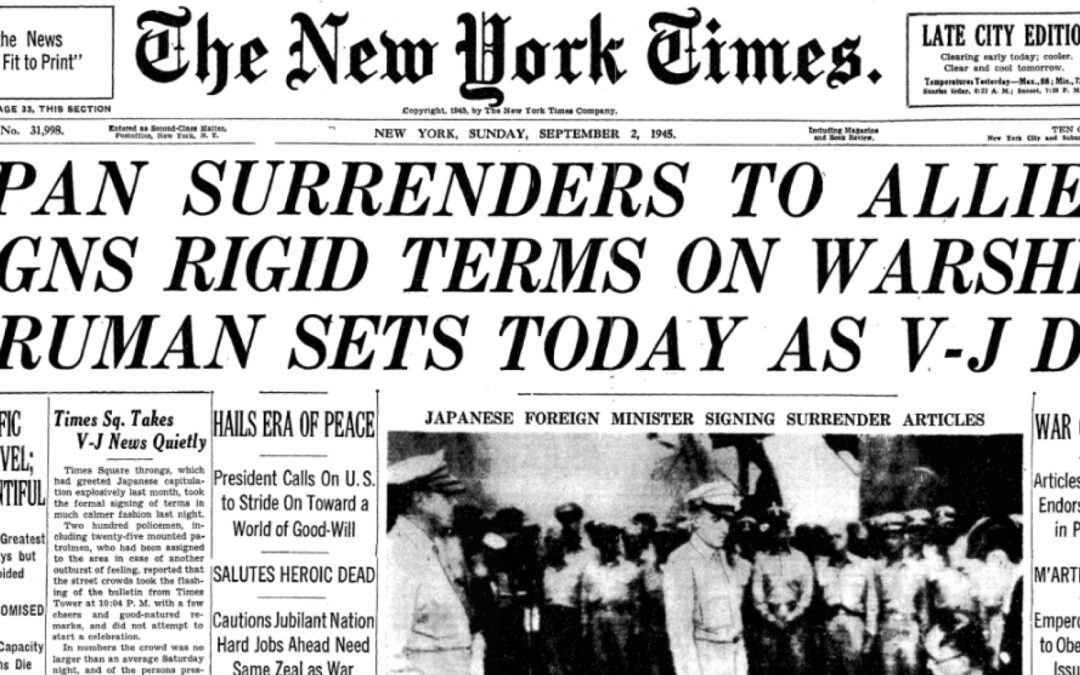#ForgottenFriday – VJ Day: Victory Over Japan
Victory over Japan Day (also known as V-J Day, Victory in the Pacific Day, or V-P Day) is the day on which Imperial Japan surrendered in World War II, in effect bringing the war to an end.
The term has been applied to both of the days on which the initial announcement of Japan’s surrender was made; 15 August 1945, in Japan, and to 2 September 1945, in Allied countries, when the surrender document was signed, officially ending World War II.
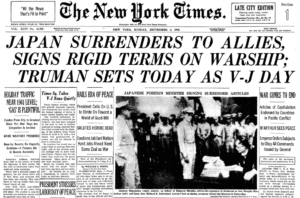
New York Times reports of Japan’s signed surrender, 2nd September, 1945
“We call upon the Government of Japan to proclaim now the unconditional surrender of all the Japanese armed forces, and to provide proper and adequate assurances of their good faith in such action. The alternative for Japan is prompt and utter destruction.”
(Proclamation by the Heads of Government, United States, United Kingdom and China, 26 July 1945)
The End of World War II
‘VJ Day’, Victory over Japan Day, is marked by Japan and the UK on 15 August. The United States marks it on 2 September, the anniversary of the signature of the Instrument of Surrender on the USS Missouri in the presence of General Douglas Macarthur, Supreme Commander in the Southwest Pacific theatre.
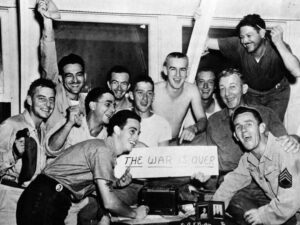
US Soldiers celebrating the end of the war, 2nd Sept 1945
The end of the Second World War was a cause for celebration on the part of the victors, and relief to all those tired of fighting. Yet many conflicts remained to be resolved and problems tackled. For the defeated, relief was tinged with despair and disbelief, even guilt. But the wider context of VJ Day so many years ago was complex, for all those involved.
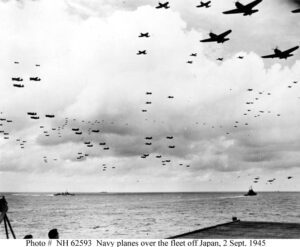
Navy Aircraft Flyover in ceremony as Japan surrenders
From Pearl Harbor to Hiroshima and Nagasaki
Japan’s devastating surprise aerial attack on the U.S. naval base at Pearl Harbor on Oahu, Hawaii, on December 7, 1941, capped a decade of deteriorating relations between Japan and the United States and led to an immediate U.S. declaration of war the following day. Japan’s ally Germany, led by Adolf Hitler, then declared war on the United States, turning the war raging in Europe into a truly global conflict. Over the next three years, superior technology and productivity allowed the Allies to wage an increasingly one-sided war against Japan in the Pacific, inflicting enormous casualties while suffering relatively few. By 1945, in an attempt to break Japanese resistance before a land invasion became necessary, the Allies were consistently bombarding Japan from air and sea, dropping some 100,000 tons of explosives on more than 60 Japanese cities and towns between March and July 1945 alone.
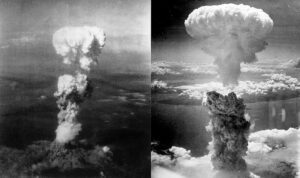
Atomic Attack on Japan
The Potsdam Declaration, issued by Allied leaders on July 26, 1945, called on Japan to surrender; if it did, it was promised a peaceful government according to “the freely expressed will of the Japanese people.” If it did not, it would face “prompt and utter destruction.” The embattled Japanese government in Tokyo refused to surrender, and on August 6 the American B-29 plane Enola Gay dropped an atomic bomb on the city of Hiroshima, killing more than 70,000 people and destroying a 5-square-mile expanse of the city. Three days later, the United States dropped a second atomic bomb on Nagasaki, killing another 40,000.
The Official Document
The Japanese Instrument of Surrender was the written agreement that formalized the unconditional surrender of the Empire of Japan, marking the end of World War II. The ceremony which lasted 23 minutes was held aboard the deck of the USS Missouri and was broadcast throughout the world. The Instrument was first signed by the Japanese foreign minister Mamoru Shigemitsu “By Command and on behalf of the Emperor of Japan and the Japanese Government” at 9:04 am.

Japanese Foreign Minister Mamoru Shigemitsu signs the Instrument of Surrender to formally end World War II
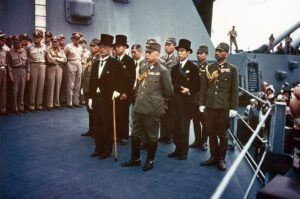
Surrender of Japan, Tokyo Bay, 2 September 1945. Representatives of the Empire of Japan on board USS Missouri (BB-63) during the surrender ceremonies.
U.S. General of the Army Douglas MacArthur accepted and signed the surrender in his capacity as Supreme Commander for the Allied Powers. It was later also signed by representatives from the Republic of China, United Kingdom, Soviet Union, Australia, Canada, France, Netherlands and New Zealand.

General Douglas McCarthur who signed the Instrument on behalf of the US
Celebration and remembrance
Of course VJ Day was a cause for celebrating the end of the war. But the way it ended, and in particular the use of the atomic bomb, meant that the legacy of the war against Japan would remain complex and contested. Ever since 1945, the memorialising of VJ Day has been the trigger for controversy, guilt and sadness, as well as for grateful recognition of the service of those who fought.

